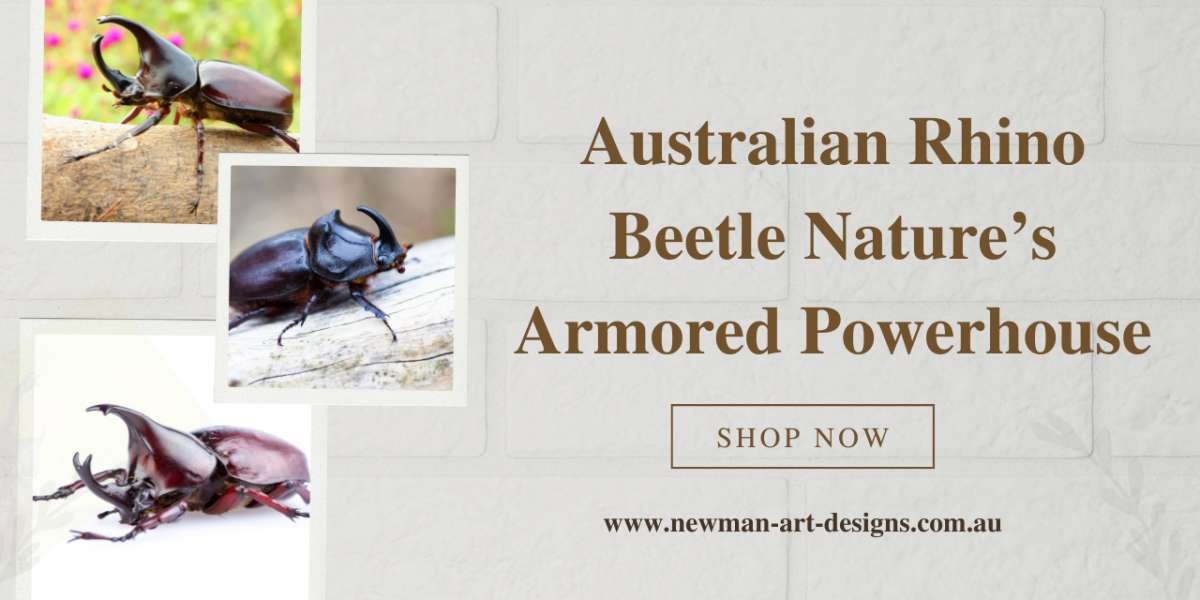Australia is home to some of the most unique and fascinating creatures on the planet, from the iconic kangaroo to the mysterious platypus. Among these natural wonders is a smaller, yet equally captivating insect—the Australian rhino beetle. Known for its impressive horns and powerful build, this beetle has intrigued entomologists and nature enthusiasts alike. In this blog, we will explore the fascinating world of the Australian rhino beetle , delving into its biology, behavior, ecological importance, and its place in Australian culture.
Introduction to the Australian Rhino Beetle
The Australian rhino beetle, scientifically known as Xylotrupes ulysses , is a member of the Scarabaeidae family. This beetle is closely related to other rhino beetles found worldwide, but it has distinct features and behaviors that make it uniquely Australian. Found in the tropical and subtropical regions of Australia, particularly in Queensland, this beetle is one of the largest and strongest insects in the country.
Physical Characteristics
The Australian rhino beetle is easily recognized by its large size and the prominent horns on its head, which resemble those of a rhinoceros. Males are particularly striking, with two long, curved horns used for fighting and mating. These horns are a key characteristic of the species and are made of chitin, the same tough material that makes up the beetle's exoskeleton.
Males can grow up to 6 centimeters in length, with females being slightly smaller and lacking the prominent horns. The beetle's body is typically black or dark brown, with a glossy, armored appearance. This exoskeleton not only provides protection from predators but also gives the beetle its formidable look.
Life Cycle and Behavior
The Australian rhino beetle undergoes a complete metamorphosis, similar to other beetles. Its life cycle includes four stages: egg, larva, pupa, and adult. Each stage plays a crucial role in the development and survival of the beetle.
Egg and Larval Stage
The life of an Australian rhino beetle begins as a tiny egg laid in decaying wood or compost. The female beetle chooses these sites carefully, as the larvae will need a rich source of organic material to feed on as they grow. Once the egg hatches, the larva, also known as a grub, emerges.
The larval stage is the longest part of the beetle’s life cycle, lasting several months to over a year. During this time, the grub feeds on decaying plant matter, growing larger and stronger. These grubs are white or cream-colored with a distinct C-shaped body. As they feed, they help break down organic material, playing a vital role in the decomposition process and nutrient cycling in their environment.
Pupal and Adult Stage
After reaching its full size, the larva enters the pupal stage, where it undergoes a transformation into its adult form. The pupa is encased in a protective cocoon, where it will remain for several weeks. During this time, the beetle’s body undergoes significant changes, with the development of its horns, wings, and exoskeleton.
Once the transformation is complete, the adult beetle emerges from the pupa. Adult Australian rhino beetles are primarily nocturnal, meaning they are most active at night. They are strong fliers and can cover significant distances in search of food and mates. Despite their fearsome appearance, these beetles are harmless to humans and do not bite or sting.
The Role of Horns and Mating Behavior
The most distinctive feature of the Australian rhino beetle is its horns, which play a crucial role in its mating behavior. Males use their horns to battle other males for access to females, a behavior known as “intrasexual selection.” These battles can be intense, with the males locking horns and attempting to flip each other over. The winner of these contests earns the right to mate with the female.
The size and strength of a male’s horns are often indicators of its fitness and ability to compete. Larger horns are typically seen as a sign of a healthier and more dominant beetle, giving it a better chance of securing a mate. Interestingly, the female Australian rhino beetle lacks these prominent horns, highlighting the different roles that males and females play in the species’ reproduction.
Ecological Importance
The Australian rhino beetle is more than just a fascinating insect; it also plays a significant role in its ecosystem. As larvae, these beetles help break down decaying wood and plant material, contributing to the decomposition process. This activity is essential for recycling nutrients back into the soil, promoting healthy plant growth and maintaining the balance of the ecosystem.
In addition to their role in decomposition, adult Australian rhino beetles are also part of the food chain. They serve as prey for various animals, including birds, mammals, and other insects. This makes them an important food source for many species, further highlighting their ecological significance.
The Australian Rhino Beetle in Culture
The Australian rhino beetle holds a special place in Australian culture, particularly in the regions where it is most commonly found. In some indigenous cultures, the beetle is revered for its strength and resilience, qualities that are highly valued in these communities. The beetle's powerful image has also made it a popular subject in local art and storytelling.
In modern times, the Australian rhino beetle has gained popularity as a pet among insect enthusiasts. Its impressive size, unique appearance, and relatively easy care make it an attractive choice for those interested in keeping exotic insects. Additionally, the beetle's battles have inspired insect fighting contests, similar to those seen in Japan with other species of rhino beetles.
Conservation and Challenges
Like many other species, the Australian rhino beetle faces challenges in the wild. Habitat loss due to deforestation and urban development poses a significant threat to its population. The removal of decaying wood and other organic material, which serves as a breeding ground for the beetles, can also affect their ability to reproduce.
Conservation efforts are essential to ensure the survival of the Australian rhino beetle. Protecting natural habitats, promoting sustainable land use practices, and raising awareness about the importance of these beetles in the ecosystem are all crucial steps in preserving this remarkable species.
Conclusion
The Australian rhino beetle butterfly in frame is a testament to the incredible diversity and resilience of Australia's wildlife. With its powerful horns, armored exoskeleton, and vital role in the ecosystem, this beetle is a true marvel of nature. Whether admired for its strength, studied for its unique behaviors, or appreciated for its ecological contributions, the Australian rhino beetle continues to fascinate and inspire. By understanding and protecting this species, we can ensure that it remains a part of Australia's natural heritage for generations to come.



